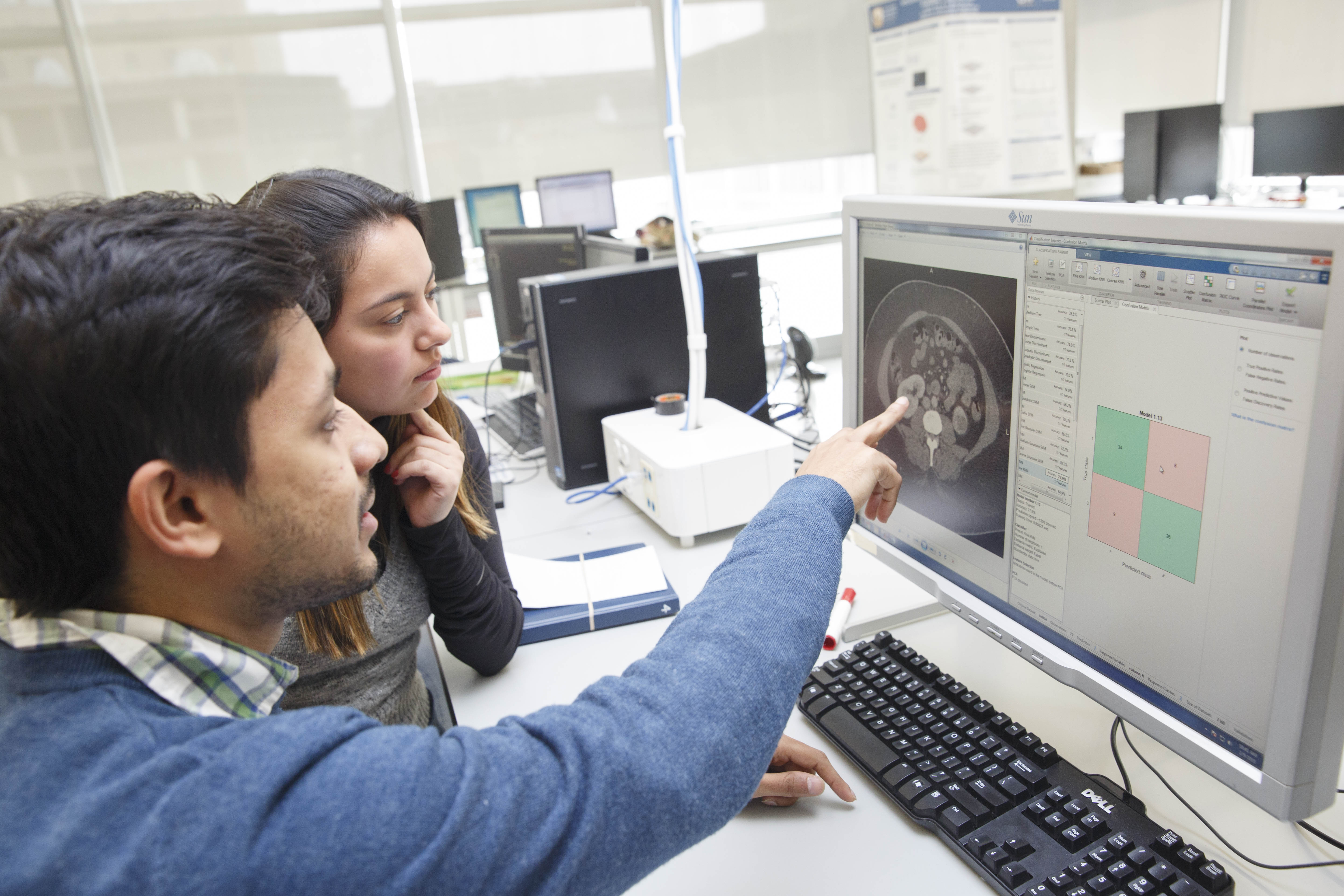Ultrasound is a valuable, non-invasive imaging tool crucial for diagnosing and monitoring various medical conditions. Every year, the American Institute for Ultrasound in Medicine hosts the conference, UltraCon, uniting leading experts and professionals of all skill levels from the medical ultrasound field. At UltraCon 2024, these individuals convened in Austin, Texas, from April 6 to 10 to explore the latest advancements and trends shaping the future of ultrasound technology and practice. GW Engineering graduate student Alessio Denny and undergraduate senior Alexis Carmine represented the Department of Biomedical Engineering at this year’s conference. Read on to learn about their cutting-edge research below.
Investigating Cornea Damage Induced by Ultrasound
Many patients suffer from various corneal disorders, such as infection, keratoconus, and genetic disorders of the cornea, every year. Denny explains, “On one hand, ultrasound shows promise in treating these conditions, while on the other hand, ultrasound may also cause undesired biological effects in the cornea and other neighboring ocular tissues.”
In his study titled “Conventional Scanning Electron Microscopy Analysis of Cornea Surface Damage Induced by Ultrasound,” Denny investigated and quantified lesions, in the form of pits, to the corneal cell membranes using scanning electron microscopy (SEM) after applying ultrasound at varying frequencies and intensities. To uncover the relationship between the frequency and intensity of the total lesion area, he employed a variety of mathematical tools, including integral equations, proportionality calculations, and curve fitting.
Denny says differential equations also played a crucial role in his work, “describing the mechanism of the ultrasound waves passing through the corneal tissue to obtain further insight into the effect of ultrasound on the corneal epithelium.” His research was done in collaboration with Dr. Anastas Propratiloff, director of the GW Nanofabrication and Imaging Center (GWNIC), and his team from GWNIC. The results were presented by Dr. Vesna Zderic, professor and department chair of biomedical engineering, by delegation.
“By submitting my work to the UltraCon Conference, I have gained a deeper understanding of the importance of medical ultrasound in treating different corneal diseases,” said Denny. “Additionally, I have learned how crucial it is to use an appropriate stylistic language to enable a broader audience to comprehend the study’s findings.”
Applying Ultrasound for Melatonin Release
Ultrasound also has the potential to provide therapeutic benefits to treat a variety of ailments. Carmine cited sleep disorders as one example of a medical condition that can be treated using ultrasound as a substitution for exogenous substances. “Imagine receiving a short treatment at a clinic and having perfect sleep cycles; this could be the future of medicine. And this is only one example of what therapeutic ultrasound offers. Dr. Zderic’s lab also studies the possibilities of increasing thyroid gland function, among many other interesting topics.”
In her study titled “Ultrasound Modulation of Melatonin Release,” Carmine explored the potential of applying ultrasound to stimulate the pineal gland, releasing melatonin. She used different ultrasound frequencies on pineal glands for five minutes, collecting the liquid surrounding the glands before the ultrasound, right after the ultrasound application, and then 25 minutes after the application had ended. Utilizing an ELISA kit, Carmine examined the liquid to determine the melatonin levels in each sample.
Carmine's findings indicate that at 800kHz of ultrasound, there was significance when comparing the liquid collected at the 0-minute mark to the 30-minute mark. She traveled to the UltraCon conference to present the results of her project, which she says could be monumental for solving sleep disorders.
“Attending the UltraCon conference and getting to see so much research currently being conducted across the world pertaining to ultrasound was an amazing experience. Before this conference, I had no idea how vast this research space was and how scientists are using new technologies, such as AI, to continuously improve ultrasound and its capabilities,” Carmine stated.
Carmine says one of her favorite talks at the conference involved an explanation of how ultrasound images can now predict the timing of a baby’s delivery, including premature births. She also had the opportunity to observe the acquisition of various images and experiment with different transducers. Lastly, the conference coincided with the total eclipse passing through Austin, Texas, which Carmine said made attending a truly unforgettable and once-in-a-lifetime experience for her.
“Overall, I am so grateful to have been able to attend this conference and experience the wonderful city of Austin! I never would have imagined I could take part in such a wonderful experience during my undergraduate years,” said Carmine, who will enter the National Institutes of Health’s (NIH) prestigious Postbac Program upon graduation.


